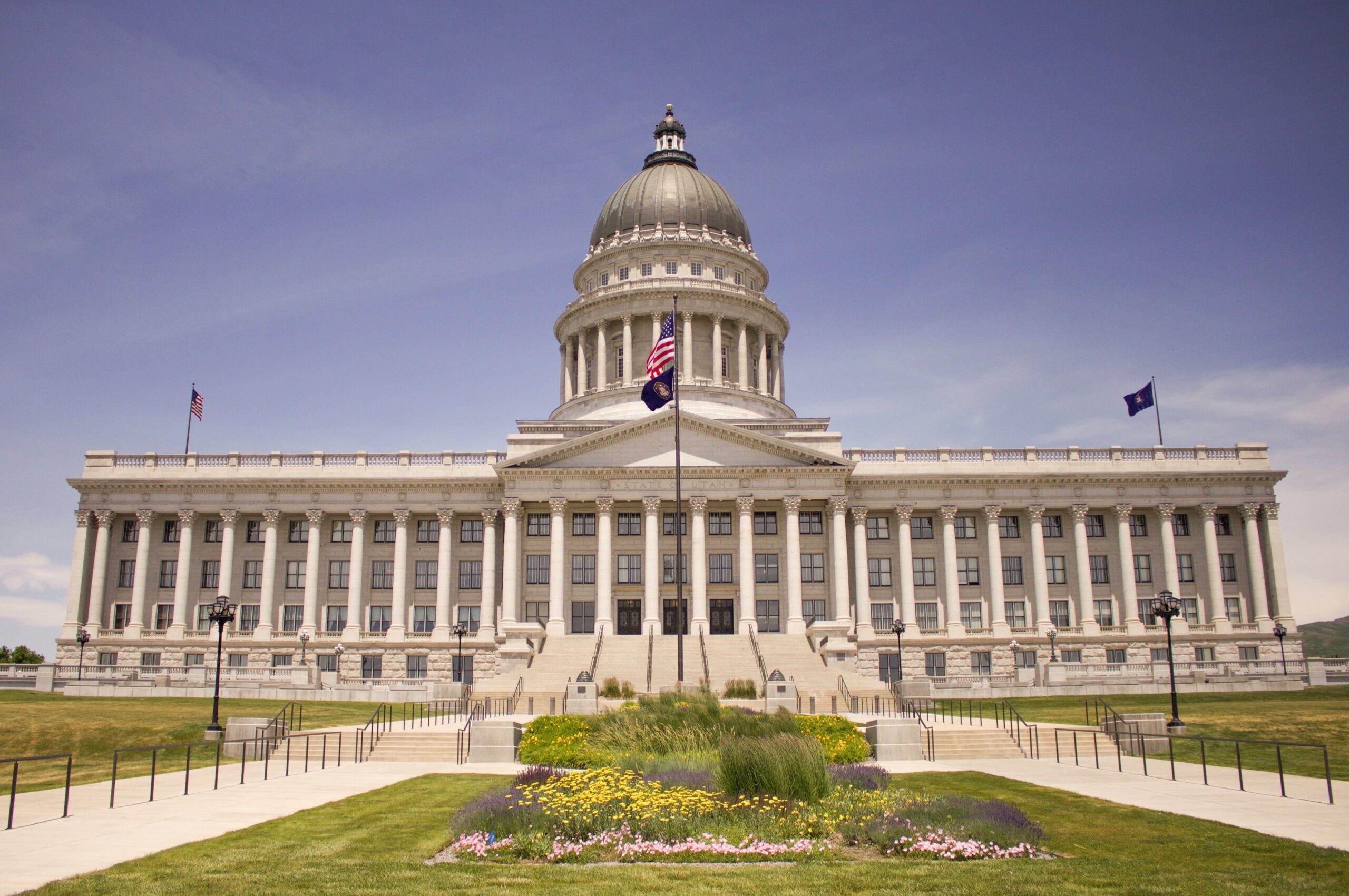
Legislative Session Recaps
2019 Legislative Session Recap
Overview
The 2019 legislative session saw a wave of state legislation aimed at tackling some of the greatest environmental threats facing the US. Environmental state legislators won historic victories, as with enhanced renewable energy standards, united rebukes against offshore drilling, and precedent-setting plastic pollution legislation. These are just some of the environmental victories from states this year.
Offshore Drilling
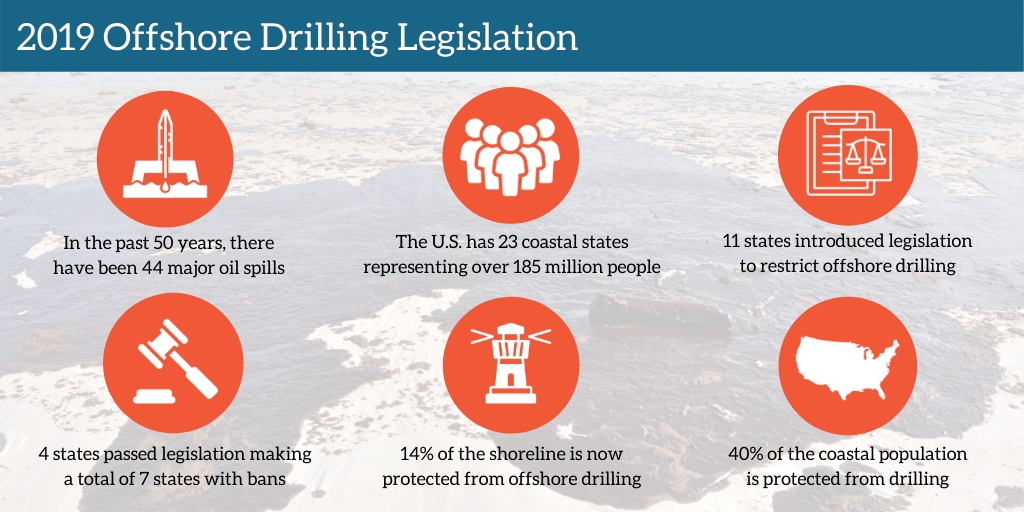
Eleven states introduced bills that would ban or restrict expanding offshore drilling. States have the authority to control water within three miles off the coast as well as permitting and construction of any infrastructure. In 2018, California, Delaware, Maryland, and New Jersey passed legislation implementing a ban or restriction.
Successful Legislation:
- Oregon (SB256) – bans new offshore drilling and drilling infrastructure in state waters.
- New York (A.2752/S.2316) – bans new offshore drilling and drilling infrastructure in state waters.
- New Hampshire (SB76) – bans new offshore drilling and drilling infrastructure in state waters.
- Maine (LD 955) – bans new offshore drilling and drilling infrastructure in state waters.
- South Carolina (Budget Provision) – for one year, bans budget funds to be used to establish refineries, pipes, and other infrastructure for drilling.
Clean Energy
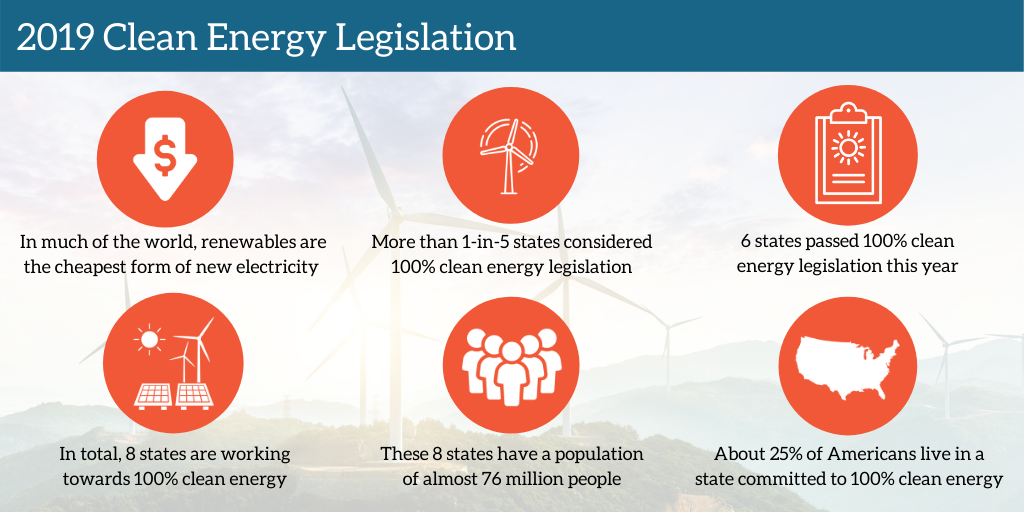
Out of the 12 states considering bills, five states enacted legislation. Puerto Rico also passed a 100% bill this year. Colorado’s bill includes a 100% renewable energy goal instead of a mandate.
In addition to increasing renewable energy standards, states have looked at other ways of increasing renewable energy usage and decreasing emissions. South Carolina passed a landmark solar bill that eliminates the cap on net metering and promotes the continued growth of solar. Washington State passed a bill to reduce emissions from large buildings through building efficiency.
Successful Legislation:
- Maine (LD 1284) – Reduce greenhouse gas emissions by 80% and transition to 100% renewable energy by 2050.
- New Mexico (SB489) – Transitions state to 100% clean energy by 2045.
- New York (A 8429/S 6599) – Transitions state to 70% #renewableenergy by 2030, 100% carbon-free electricity by 2040, and net-zero greenhouse gas emissions by 2050.
- Nevada (SB 358) – Transitions state to 50% RPS with a goal of 100% carbon free by 2050.
- Washington (SB5116) – 100% clean energy by 2045.
- Maryland (SB 516) – increases RPS to 50% by 2030 and will look at the viability of 100% by 2040.
- South Carolina (HB 3659) – removes the cap on net metering and promotes solar energy.
- Washington (HB 1257) – establishes efficiency standards for buildings over 50,000 square feet.
Carbon Pricing
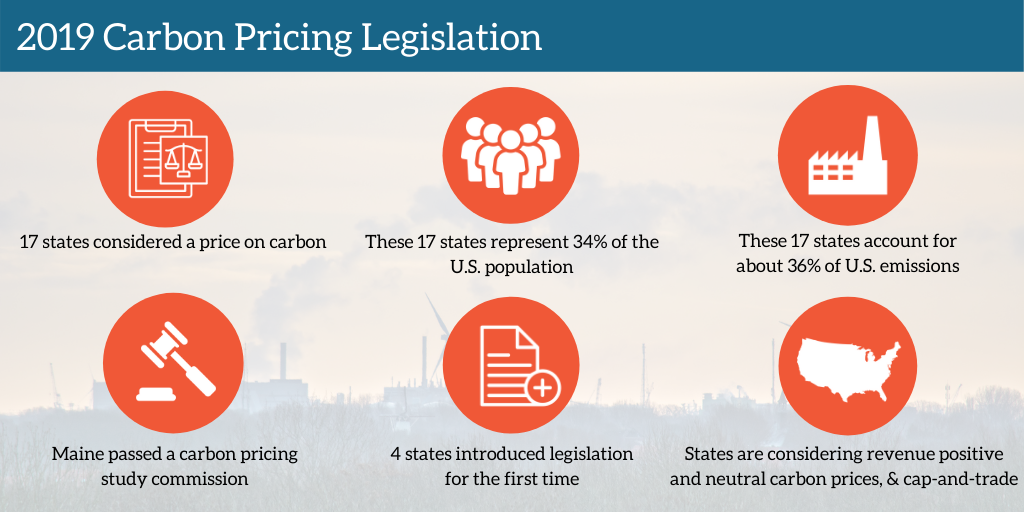
Momentum around state carbon pricing continues to grow each year. The 2019 legislative session saw 44 bills introduced in 17 states, compared to 33 bills in 13 states in 2018. Maine, Montana, and Texas all introduced a carbon pricing bill for the first time. This year, all eyes were on Oregon as they pushed to pass HB 2020, a cap and invest bill. HB2020 would place a cap on greenhouse gas emissions, making them the second state to do so. Oregon’s House of Representatives passed the bill, however it did not pass the Senate.
Successful Legislation:
- Maine (LD 434) would have implemented a price on carbon. However, the bill was converted to a study commission and passed after being incorporated in the Governor’s Climate Change Council (LD 1679).
- Oregon (HB 2020) would have established a cap-and-trade system. While the bill did not fully pass, it did pass the House of Representatives.
- Hawaii (HB 852) provided funding for a carbon pricing study.
Conservation
Wildlife Corridors
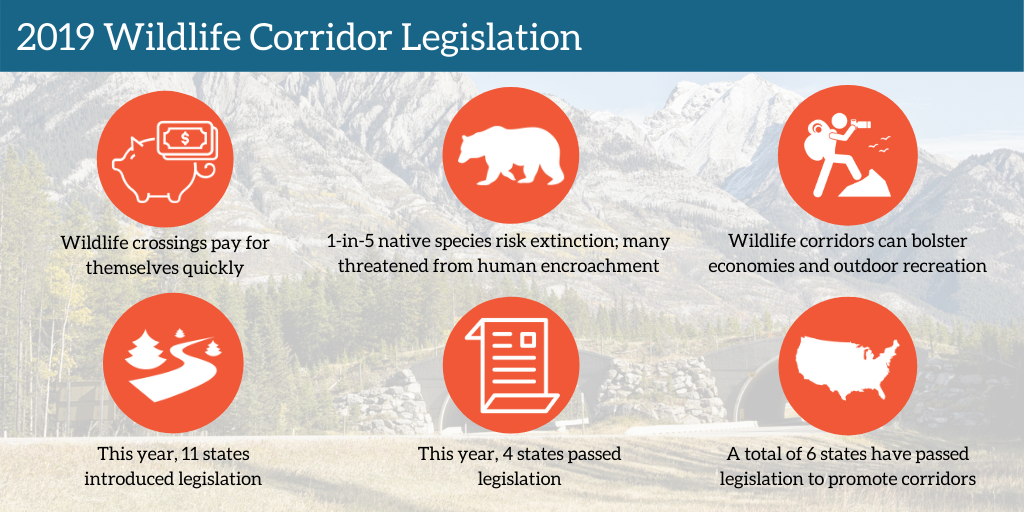
Wildlife corridors and crossings are vital and cost-effective ways to maintain resilient ecosystems and to protect public health and safety on roads. This year saw 11 states consider legislation with four states passing legislation thus far.
Successful Legislation:
- New Mexico (SB 228) – requires a Wildlife Corridor Action Plan to provide guidance for identifying, prioritizing, and maintaining areas for wildlife movement.
- Oregon (HB 2834) – requires the Department of Fish and Wildlife to study and develop a Wildlife Corridor and Safe Road Crossing Action Plan to implement wildlife corridors.
- New Hampshire (SB 200) – requires the recognition and protection of wildlife corridors and habitat strongholds as a public good.
- California (SB 85 – public resources omnibus trailer bill) – Appropriates $2 million in matching funds for local agencies to acquire wildlife corridors and urban trails and for similar programs.
Outdoor Recreation
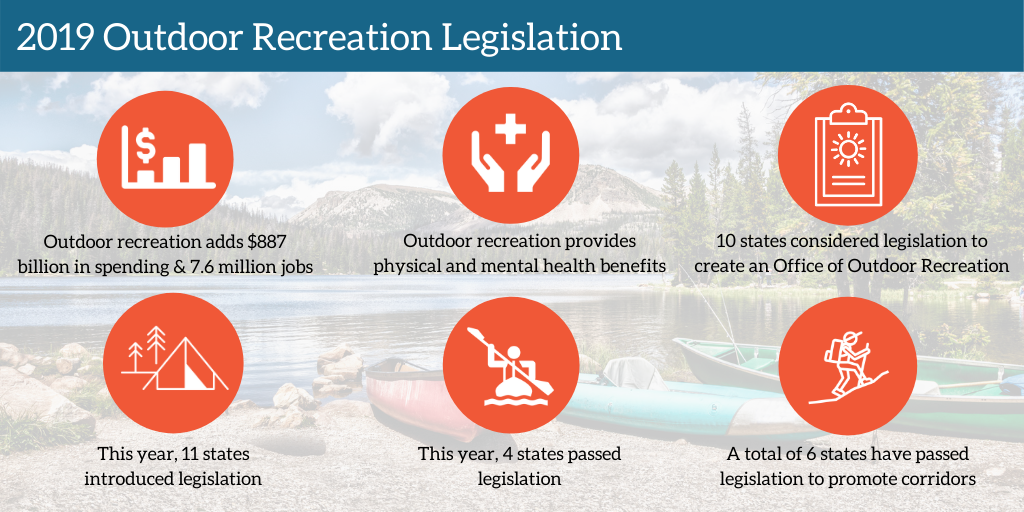
The benefits of time outside are becoming harder to ignore. A connection between nature and health outcomes has been repeatedly demonstrated and continuously built upon. Two of the major policy areas states pursued include establishing offices of outdoor recreation and encouraging outdoor recreation through grant programs.
Successful Legislation:
- New Mexico (SB 462) passed a bill creating an Office of Outdoor Recreation with the nation’s first Outdoor Recreation Equity Fund to help get low-income and disadvantaged youth outside.
- Minnesota passed a No Child Left Inside Grant program that will provide funding to public entities or nonprofit organizations that connect students with nature.
- Nevada (AB 331) created an outdoor education and recreation grant program to connect youth with nature.
- Nevada (AB 486) established a Division of Outdoor Recreation.
- Utah (HCR 4) passed a resolution supporting Utah’s every kid outdoors initiative.
- Utah (SB 222) also passed an outdoor education and recreation grant program.
Pollinators
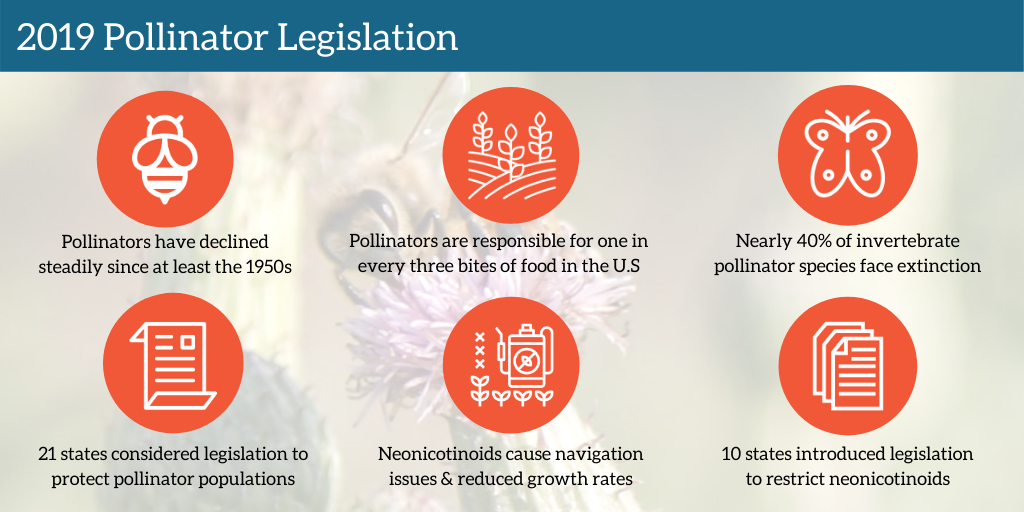
States continue to make strides towards protecting pollinators. Minnesota passed numerous pollinator protections including a grant program to encourage pollinator friendly yards, establishing a state bee. Many other states, such as Pennsylvania and New Mexico also introduced and passed pollinator bills.
There has been a national movement, led by states, to limit the use of neonicotinoids which have been shown to cause bees to struggle with simple navigation and experience reduced growth rates. There were 10 states considering legislation to restrict the usage of neonicotinoids. Both Vermont and Hawaii passed their bills.
Successful Legislation:
- Vermont (H 205) passed a bill restricting the usage of neonicotinoids.
- Hawaii (SR 136) recognizes the importance of pollinators and the threats from neonicotinoids.
- Minnesota passed a Lawns to Legumes (HF 776) program to provide funds to help convert lawns by planting wildflowers, clover, and native grasses.
- New Mexico (SB 234) establishes a pollinator license plate.
- Pennslyvania (HR 385) established June 17-23, 2019 as pollinator week in PA.
Environmental Health
Plastic Pollution
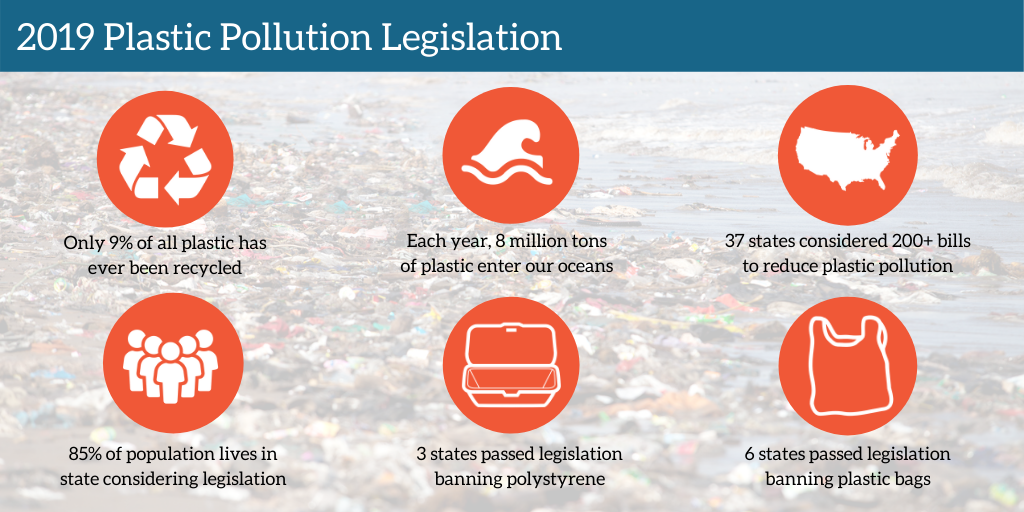
This year saw a boom in legislation to combat plastic pollution. There was a growth of knowledge around the issue of plastics in 2018, and this new-found public concern was evident by the number of bills introduced. There were more than 220 bills introduced in 37 states aimed at tackling plastic pollution from different angles – banning plastic bags, plastic straws, and styrofoam; creating task forces; and establishing extended producer responsibility.
Successful Legislation:
- Maryland (SB 285/HB 109) and Maine (LD 289) both passed bills banning polystyrene, more commonly known as styrofoam.
- Delaware (HB130), New York (S1508C), Maine (LD 1532), Oregon (HB 2509) banned single-use plastic bags.
- Oregon (SB 90) bans plastic straws except upon request.
- Vermont (S113) passed the most comprehensive single-use ban in the country, banning plastic straws, single-use bags, polystyrene, and food serviceware.
- Washington state (SB5397) established a study that will assess the impacts of plastics packaging to ultimately help implement and show the value of extended producer responsibility.
- Hawaii (SB 522) established a single-use plastic reduction working group.
Toxic Chemicals
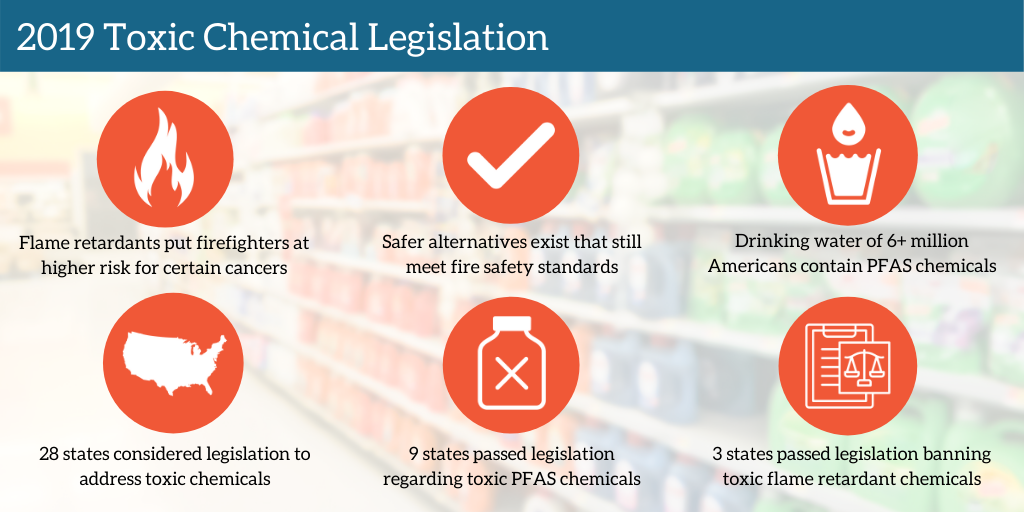
State action on toxic chemicals ranges from efforts to ban flame retardants to addressing concerns over PFAS, also known as “forever chemicals.” Concern, awareness, and action on PFAS chemicals continue to grow each year. While flame retardants were created to help reduce the risk and spread of fires, they have been found as ineffective and harmful to human health.
Successful Legislation:
- Arizona (SB 1526) prohibits use of PFAS-containing firefighting foam for training.
- Colorado (HB 1279) prohibits the sale of PFAS-containing firefighting foam in certain circumstances, prohibits use for firefighting training, requires manufacturers to disclose if protective equipment includes PFAS, requires Department of Health to conduct a survey to determine the amount of PFAS foam currently held, used, and disposed of by fire departments.
- Georgia (HB 458) prohibits use of PFAS-containing firefighting foam for training.
- Kentucky (SB 104) prohibits the use of PFAS-containing firefighting foam for training purposes.
- Maine (LD 1433) prohibits the sale of food packaging with intentionally added toxic heavy metals, PFAS, or phthalates.
- Minnesota (HF 2209) bans manufacture and sale of organohalogen flame retardants in residential upholstered furniture, children’s products, residential textiles, and mattresses. Prohibits the use of PFAS-containing firefighting foam for training purposes.
- New Hampshire (SB 193) prohibits the sale of certain furniture and carpeting with flame retardant chemicals.
- Vermont (SB 49) sets maximum containment level for five PFAS chemicals in water, requires testing, requires landfills to treat leachate to remove PFAS chemicals.
- Virginia (HB 2762) prohibits the use of PFAS-containing firefighting foam for training purposes.
- Washington toxic chemical (SB 5135) directs the Department of Ecology to identify and take regulatory action on consumer products that are a significant source of chemicals that are a concern for sensitive populations and species. Prioritizes PCBs, PFAS, organohalogen flame retardants, phthalates, and phenolic compounds (BPA, APEs) for initial consideration.